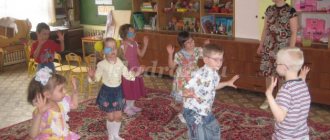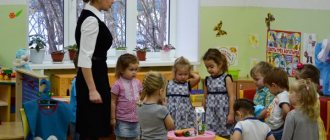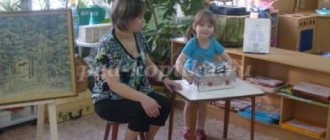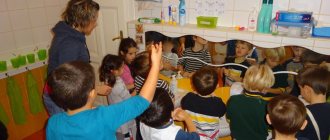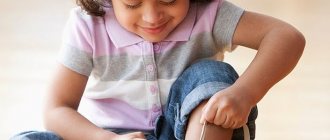Summary of GCD in the second junior group on the topic: Healthy lifestyle
Summary of educational activities in the second junior group Theme “Wash your face every day”
Author: Larisa Anatolyevna Kokurina, teacher of the preschool educational institution “Kindergarten No. 38”, the city of Shuya, Ivanovo region. Description: This summary will be useful to both preschool teachers and parents. The material is written for children 3-4 years old, but depending on the age of the children, it can be complicated or simplified. Goal: to develop culturally hygienic skills in children through work. Objectives: 1. Strengthen children’s skills in washing, knowledge of toilet items and their purpose. 2. Introduce some properties of water. 3. Strengthen the ability to perform labor actions, soap a sponge, rub dolls with it, rinse with water, wring out sponges. 4. Develop speech, activate the words slob, neat, transparent in speech. 5. Develop cultural and hygienic skills, the desire to be beautiful and clean. 6. Respect your body, desire to help, kindness, responsiveness. 7. Develop the ability to work in pairs and negotiate with a partner. 8. Develop observation and curiosity. Equipment: multi-colored basins with water, washcloths, soap, towels, dirty dolls, a diagram of the hand washing algorithm and Ted, pictures of bath accessories, three drawn boys (clean - dirty, clean). Preliminary work : reading nursery rhymes while washing, reading K. Chukovsky’s fairy tale “Moidodyr”, conversations “How do we wash our hands?”, “I don’t want to be dirty”, “Cleanliness is the key to health”, looking at plot pictures, illustrations, the game “Who can Wash cleanly?”, training in labor actions with sponges. Integration of educational areas: “Cognitive development”, “Speech development”, “Socio-communicative development”, “Physical development”
Progress of NOD
Organizational moment Welcoming children mood in an emotionally positive way We stomp our feet! We clap our hands and now we will turn around and smile at each other. (Knock on the door)
- You hear someone knocking.
Let's go see who's there. (Behind the door there are two drawn boys, one clean and the other dirty).
The children say hello, invite them in, and introduce themselves.
Clean boy: - My name is Kolya. Dirty boy: - My name is Petya. -What’s your name? (Children introduce themselves)
.
-Look at the boys. What are they? (Boys are compared)
.
- Petya is all dirty, I wonder what happened to him? Guys, what do you think? (He got dirty and forgot to wash.) Yes, he got all dirty and came to visit us, forgetting to wash. -Look at Kolya, what is he like? (Clean.)
Yes, it is clean and tidy.
Which boy do you like to greet? (Ruts.)
Why?
(He’s clean.)
Was it nice to say hello to Petya?
(No,
why?
(He's dirty)
-Yes, this boy loves soap and tooth powder, This boy is very nice, he does well.
This one got into the mud and is glad that his shirt is dirty. They say about this guy that he’s a bad slob. -Which of these boys is a slob? (Petya.
) Who is this slob?
( A dirty, unkempt, grimy person.)
Who can you say is a slob?
(A dirty person.)
Repeat the word slob (choral and individual responses from children).
— What can you say about Kolya? What is he like? (Clean.)
He is neat.
Repeat. (Children’s round dance and individual responses). Who do we call neat? What kind of people? (Clean, tidy.)
- Look at what places Petya is dirty?
(Face, arms, legs.)
What does he need to do?
(Wash.)
Why do you need to wash?
( To be clean.
) Why do you need to be clean?
(To be beautiful, not to get sick, to be friends with you.)
I wonder, does Petya know how to wash himself?
Ask him. Petya: - No. - What to do? (Teach)
.
Petya, the guys will teach you how to wash your hands, show you and tell you how to do it. -What do we need to wash our hands? Which subjects? (Washcloth, soap, water, towel)
.
Tell us and show us how to wash our hands, and the pictures will help us with this.
D/game “Washing your hands” Goal: strengthening the hand washing algorithm, the ability to wash your hands correctly. Children arrange pictures-algorithms for sequential hand washing in order and show simulations of the hand washing process. Roll up your sleeves. Open the tap. Take soap. Lather and rub to create foam. Rinse off. Close the tap. Wipe your hands. Roll up your sleeves.
-Petya has learned to wash his hands, but other parts of his body are also dirty. Shall we show him how to wash himself? Game “Who knows how to wash clean?” (physical education session) Who knows how to wash clean? Who isn't afraid of water? This is us! This is us! This is us! (children raise their hands)
Who doesn't want to be dirty?
Does he wash his ears well? This is us! This is us! This is us! (children rub their ears with their hands)
We know how to wash ourselves.
We wash our neck with a washcloth! Like this! Like this! Like this! (depicted as rubbing the neck)
And then we will wash the head deftly over the basin.
Like this! Like this! Like this! (tilt down and pretend to wash your hair)
To wash the legs clean, We rubbed them a little And just like that!
And just like that! And just like that! (depict how they wash their feet)
We washed ourselves like big ones. Look how clean we are!
Look at us! ( turns from side to side
) Petya is given a washcloth, soap, and a towel and sent to the washroom to wash.
- Guys, don’t you hear anything? And I hear someone crying. Quiet - quiet, it's somewhere here. This is where I hear you cry. (The box opens). There's someone here. (They take out dirty dolls). What dolls? Are they dirty or clean? (Dirty
).
Yes, they are dirty and crying. Why are they crying? (Because they are dirty).
— Would you like to play with dirty dolls?
(No.)
So no one wants to play with them.
Why are dolls dirty? Could they have gotten dirty themselves? Petya got dirty himself, but how did they get dirty? (The guys got them dirty, played with dirty hands, threw them on the floor.)
-What should they do?
How to help? (Wash.)
You've already said what you need for this, but let's repeat it again.
Face - what do I wash it with? (With soap and water.)
What should you do when you wash your face with soap?
(close eyes)
.
Why? (So that your eyes don’t sting.)
Hands – with a washcloth and soap. Body - with a washcloth and soap. Legs - with a washcloth and soap.
-I have it all.
We’ll take Kolya with us so he can see how we can help the dolls become clean. -You said that you need a washcloth? Here's a washcloth that you use better than your dolls, and which side is more pleasant to rub, try it on yourself, rough or smooth? (Smooth.)
What do you think would be more pleasant for the dolls?
(Also smooth.)
- It’s better to rub to wash off all the dirt.
Dirt won't come off? It will probably work better with soap. Take soap. Smell how fragrant it is, inhale with your nose, exhale with your mouth. Doesn't lather up? Why? This means we need water. Put everything down and come to me. - What kind of water should you wash in? (Warm, clean.)
Find where the water is cold and where the water is warm.
How to make sure the water is warm everywhere? (Add warm, hot water)
.
-What color is the basin? (Blue)
What color is the water in it?
(blue)
-What color is this basin?
(Green.)
Is there water in it?
(Green)
Similar work with the other basin.
-And now I’ll pour water from this basin into a glass. What color is the water? It is colorless, clean, transparent, water has no color, look through it you can see. So in the basins we see the bottom through the water. (Show me a glass of dirty water.) -What kind of water is here? (Dirty.)
Can you see through it?
(No,
why?
(Dirty.)
What water should you wash in?
(Clean.)
-Our water is clean, clear, warm, take soap and washcloths and we will wash the dolls. You must first wet the washcloth, wring it out, lather it with soap, and then wash the dolls (the algorithm is set) soak the sponge in some water, wring it out, and wash off the soap. Remember how your mothers wash you at home, bathe you, how they carefully and tenderly do everything with love.
Children divide into pairs and wash the dolls.
While washing the dolls, songs and nursery rhymes about washing are played, and the children themselves read familiar nursery rhymes. -Which dolls have become clean. Have fun. What should you do to make them always so cheerful? And you didn't cry anymore? (Play with clean hands, carefully, neatly.)
-Look what kind of water we have?
(Dirty.)
Remember what the water was like before we started washing the dolls.
(Clean.
) Let's put the dolls in a warm place, wrapping them in a towel, let them dry and warm up.
Then we will dress them up. - Let's see how our Petya is doing, whether he has washed himself or not yet. (They take out a clean Petya). What has he become? (Clean.)
Remember what he was like?
(Dirty, slob.)
What should you do to always be neat, clean and beautiful, like Kolya?
(Wash, don’t get dirty).
-What interesting things did you learn today? What do you remember? The boys thank the children, note how they worked (they evaluate each child positively.) -Today you and I taught Petya what to do to be clean, like Kolya. We helped the dolls become clean, and next time we will remember how to take care of our clothes so that they are neat and beautiful. The boys say goodbye to the children and promise to come again and talk about clothes.
We recommend watching:
Summary of GCD on gender education in the 2nd junior group. Summary of GCD in the second junior group. Synopsis of GCD in the 2nd junior group. Fun Train Summary of an open lesson for children of the second junior group
Similar articles:
Math lesson notes. Topic: “First - then.” Second junior group
Algorithm for washing hands in kindergarten in pictures
It would seem that nothing could be easier than washing your hands. But it is better for the child to show each sequential action in the form of a picture so that it is perceived easier and faster. It is important to remember that the stand with pictures about hand washing should be placed at the level of children's eyes or slightly higher. There is no need to hang the algorithm high (as an informational one for parents) or unnoticed. The ideal option is right above the sinks intended for children.
Print out the pictures large or draw them yourself, and then talk to the children about what they see. You can even play the game by correctly placing the available pictures in the right sequence. In addition to the process itself, children should learn the accompanying words: soap, foam, wash, dry, soap dish, tap, slippery, wet, germs and others. And so, to the algorithm:
| Roll up your sleeves so as not to get them wet. |
| Open the water tap. |
| Take soap. |
| Lather your hands. |
| Wash off the foam from your hands. |
| Close the water tap. |
| Release your hands. |
| Dry yourself with a towel. |
| Pull the sleeves back down. |
Of course, the first test manipulations at the sink should be carried out by everyone together; you can even invite the children to practice on dolls. Another important point is explanation, carried out in three ways: verbal, visual and practical. They need to be presented gradually, one after the other. That is, first you tell (in the form of a game, jokes, dolls), then you show by example, and after that you all go wash your hands together.
Talking about the benefits of hand washing
To make children more willing to remember the algorithm of actions during hygiene procedures, they should be told about the benefits of this process. And it would do well for adults to be aware of the dangers that forgetfulness in this regard can bring. And so, with dirty hands we have:
- Very serious and dangerous diseases, which include Hepatitis, Typhoid Fever, Cholera, Dysentery. Of course, the child’s consciousness will not perceive or remember this word in any way, so the argument in this case is a lot of terrible microbes that will disappear from the hands only after they come into contact with soap. Otherwise, your tummy may hurt, and this is so unpleasant.
- If you touch your face, one of the most sensitive parts of the body, with dirty hands, you can get irritated. The guys should be told how their face can start to itch and turn red, and be reminded about mosquito bites.
- If you accidentally rub your eyes with a dirty hand, you can wake up the next day with conjunctivitis. Children should know that their fragile eyes are very afraid of germs.
- Dirty hands are not pretty. It is very important to instill in children an aesthetic sense from early childhood, so that in the future they will be neat and clean.
